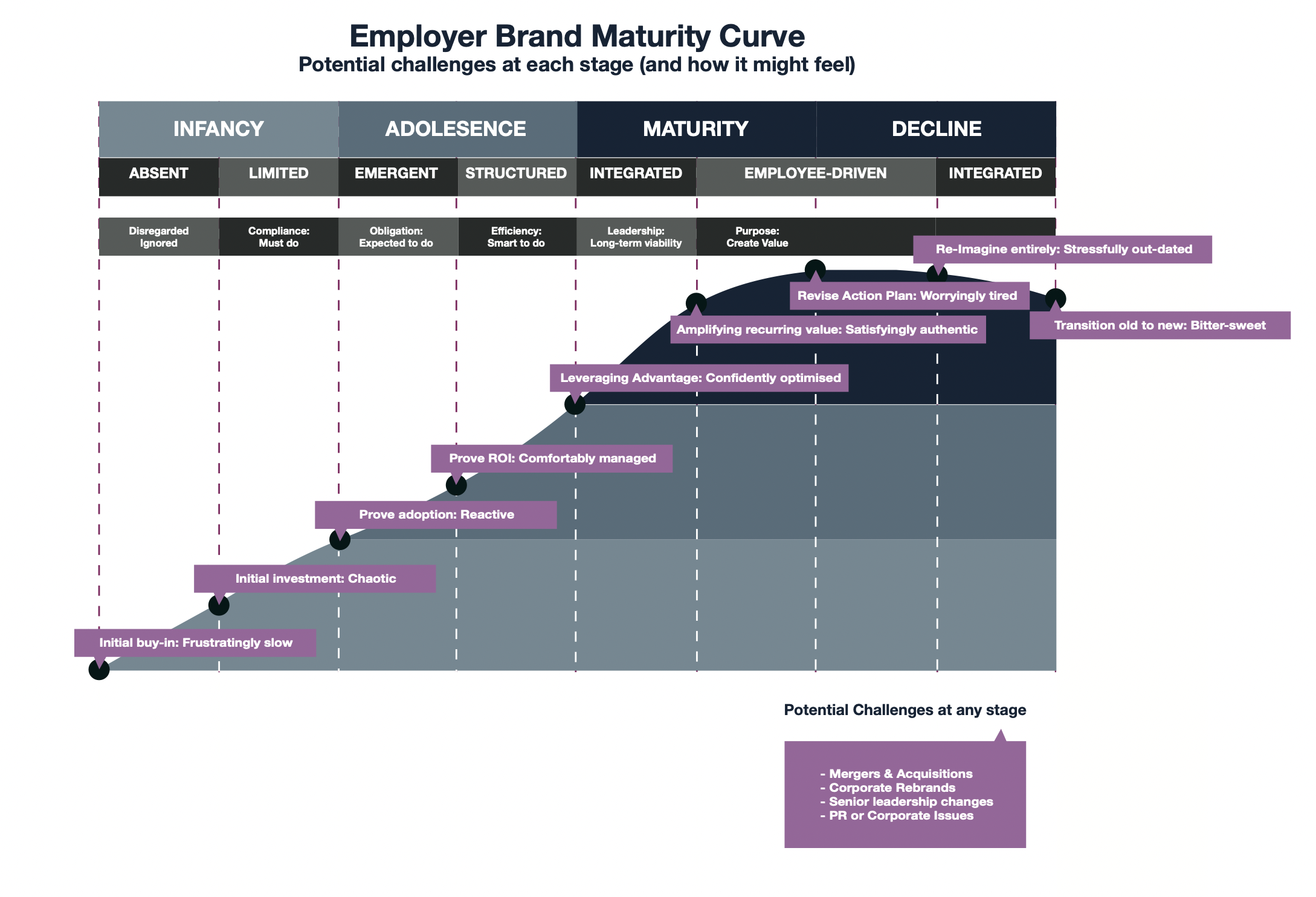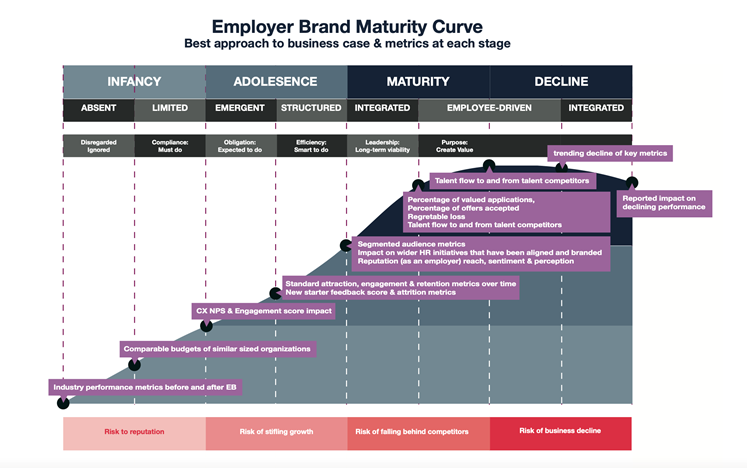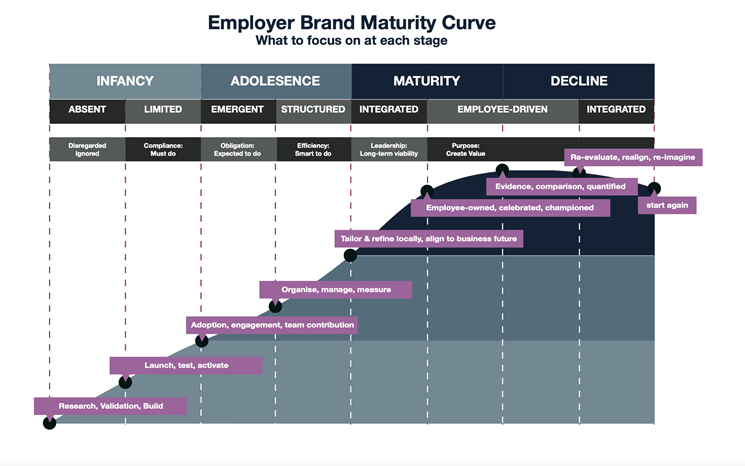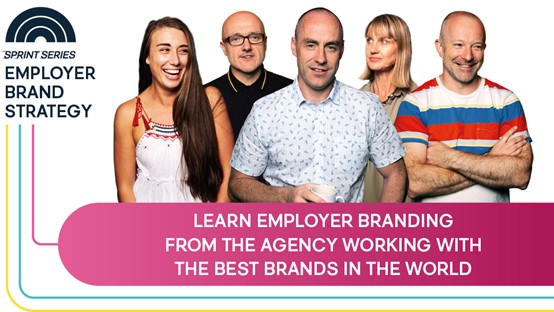Where Does Your Employer Brand sit on the Maturity Curve?
4 min read.Our Maturity Scale will help you identify which one of the four stages of Employer Branding your company is in. Once you've established where you are, you can use that knowledge as a springboard to develop your employer branding strategy and reach your goals…
The power of employer branding is unmistakable. In 2022 86% of the world's most attractive employers reported that employer branding was a top priority for their business strategies, according to Universum research. Businesses that realise the value of harnessing it are leading the charge toward better employer/employee relationships and more brand visibility, well into the future.
Employer Branding is the bridge between where the business is today and where it wants to be tomorrow. An employer brand can be highly beneficial when handled correctly as part of a wider strategy.
A well-conceived and executed employer brand can become the base of the entire employee experience from job candidates to corporate alumnus. In fact, a Glassdoor poll found that 86% of employees and job seekers research company reviews and ratings when choosing which business to apply to. The effective employer brand can even serve as free advertising, telling the world what a company stands for and what people can expect if they become part of the team.
Employer branding can be all these things and more. You must, however, take one crucial step before creating and initiating a more definitive Employer Branding action plan: Diagnose your employer brand maturity.
Gauging your employer brand maturity will help you effectively dictate the level of resources and the sophistication of your internal communications, allowing you to start making progress rather than just spinning your wheels. For example, trying to lead the employer brand charge can be painful and frustrating if you begin in the wrong place. Knowing where your company is on the employer branding maturity model ensures you know how to prioritise your next moves. That way, you can name the most immediate challenges you need to overcome and focus on what's urgent.
Below are the four stages of employer branding and how to plot your company’s position on the maturity scale. Remember; maturity has nothing to do with the size or legacy of your organisation. Your business can be anywhere on the scale. Once you've established where you are, use this knowledge as a springboard to build your employer branding strategy to reach your goals.
Stage one: Infancy
You’re in the infancy stage if your company has never thought about, not yet activated or tried and discarded an employer branding strategy. At this point, you need buy in from champions, otherwise you will struggle to get your employer branding action plan - and the corresponding budget - in place. Executives might even view an employer brand as non-essential which will reduce their investment in the concept.
To get employee branding started you must begin by researching, validating and building an early-stage employer brand plan. Get people excited about it throughout your company by explaining the many benefits that come from successful Employer Branding. Once you have some support, take what you've learned and launch a few employer brand initiatives.
The digital communications technology company Cisco, for example, is a shining beacon of employer branding done right and has won numerous awards for it. Its website is clean and easy to access, and materials are easy to find. When launching similar initiatives, be sure to test everything, share your knowledge and iterate for further support and funding down the road.
Stage two: Adolescence
When your business is in the adolescence phase, your employer branding has started to take shape. There's initial buy-in because people understand that without an employer brand they'll continue to have recruitment or attrition issues. Although some people might still see an employer brand as an obligation, most realise it is a requirement. So, you're dealing with reactive rather than proactive acceptance, appreciation and adoption.
This is a “foot in the door” stage where you want to concentrate on building team engagement. PetSmart’s employer branding strategy, for example, looked like the company showcasing its love for both pets and people. Introducing #LifeAtPetSmart has allowed employees to feel more connected to the business and their work while still maintaining the pet lovers image the brand is known for.
You can begin moving in the right direction by asking teams to manage and own the measurement of your employer branding, so you can show how ROI is moving either up or down. Key performance indicators to measure might include your net promoter score, new hire feedback scores and turnover metrics.
In the adolescent stage, you start to unify everyone around effective employer branding strategy ideas.
Stage three: Maturity
During the maturity stage, employee branding is fully aligned within your company. It's part of the future vision for the business and team members are using it as a competitive advantage. At this stage, employer branding is completely integrated as one of the sustainable factors of the organisation. Mature employer brands become so ingrained into the fabric of their corporate cultures that they are practically taken for granted.
If you think you're at the maturity stage, you can't settle for a “set it and forget it” attitude. Instead, use all the employer branding positivity and authenticity to tailor and refine your strategies even further.
Note that 20 to 30% of HR managers reported increased productivity and higher retention rates because of a well implemented employer brand. Use historical data to measure your employer brand’s impact on human resources concerns, such as the percentage of valued applications, the number of offers accepted and annual talent flow to competitors.
Stage four: Decline.
A declining employer brand frequently occurs after a major transition. It will eventually happen, however, no matter what, because Employer Branding is cyclical. It will decline after a period of full maturity. The concepts get tired, and what was refreshingly poignant or intuitive initially, gets old and broken down over time. For some businesses, old employer branding strategies might even feel out of date or misaligned with the true DNA of the organisation.
Although it sounds like a disadvantage, it's an opportunity for you to start reconstructing your reputation again with fresh enthusiasm. Research on LinkedIn found that “with even small simple tweaks companies can improve their employer branding strategies to attract, recruit and retain the best employees”.
Taking the time to breathe life back into your employer branding strategy is essential at this stage and will help ensure your business's legacy both today and well into the future.
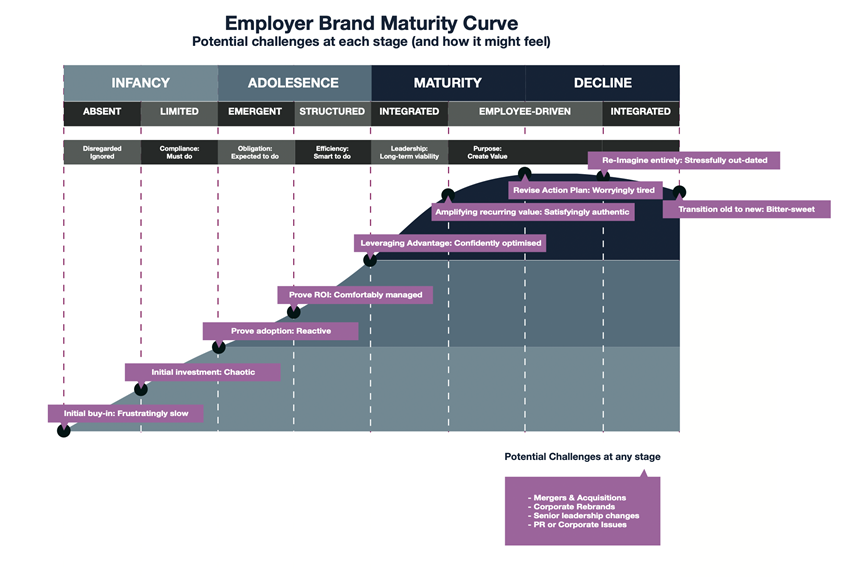 [View larger]
[View larger]